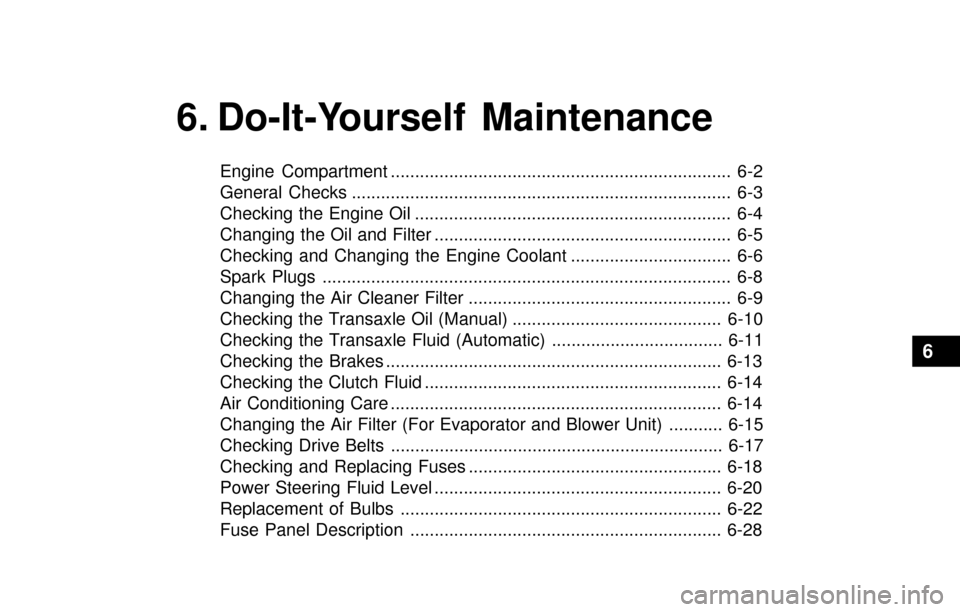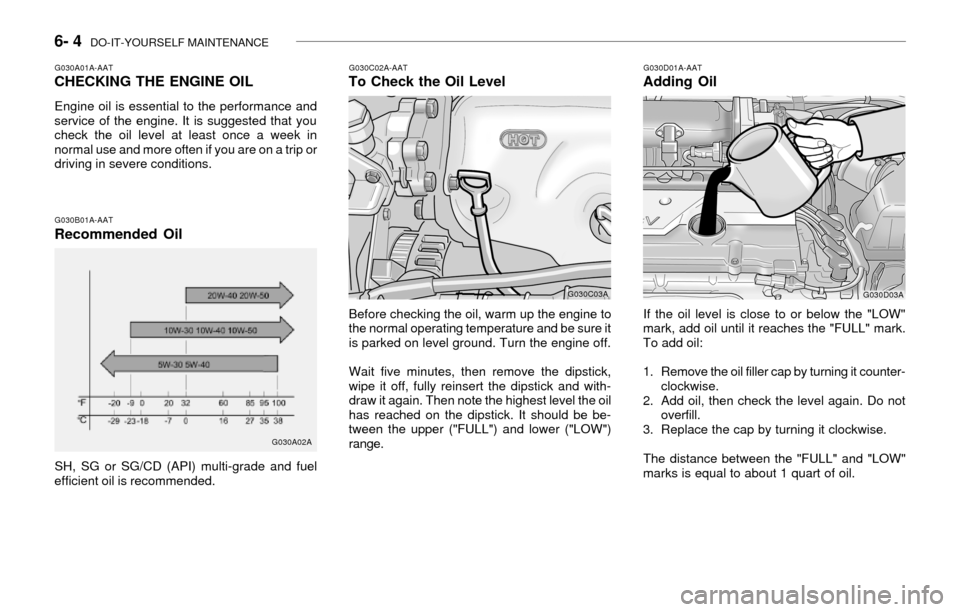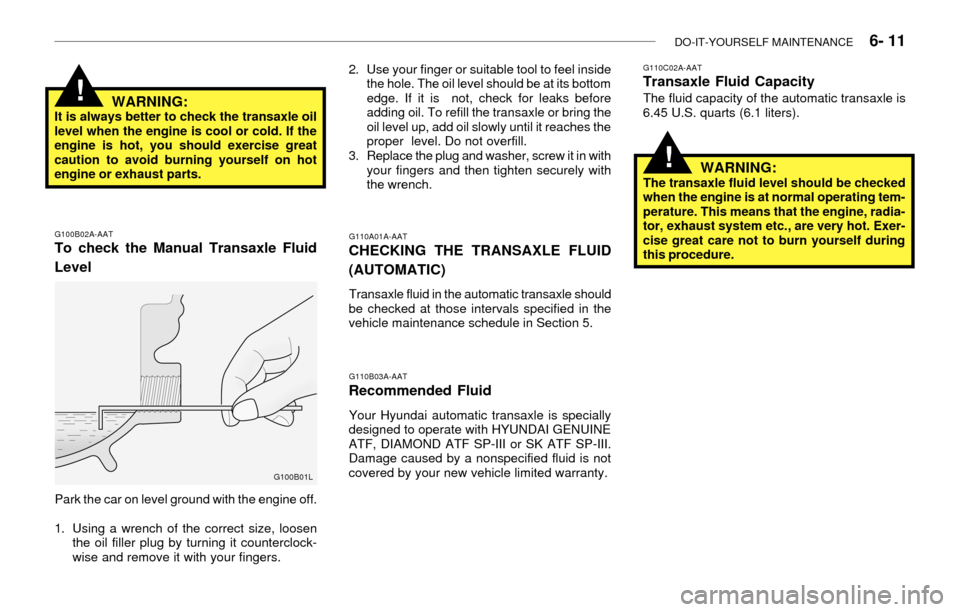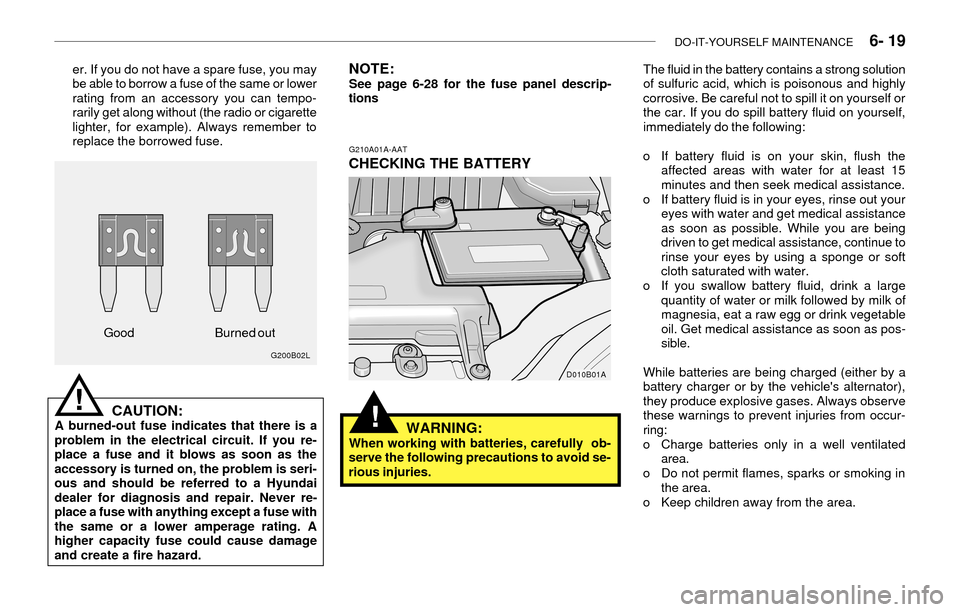checking oil Hyundai Accent 2003 Owner's Manual
[x] Cancel search | Manufacturer: HYUNDAI, Model Year: 2003, Model line: Accent, Model: Hyundai Accent 2003Pages: 186, PDF Size: 11.36 MB
Page 137 of 186

6. Do-It-Yourself Maintenance
Engine Compartment ...................................................................... 6-2
General Checks .............................................................................. 6-3
Checking the Engine Oil ................................................................. 6-4
Changing the Oil and Filter ............................................................. 6-5
Checking and Changing the Engine Coolant ................................. 6-6
Spark Plugs .................................................................................... 6-8
Changing the Air Cleaner Filter ...................................................... 6-9
Checking the Transaxle Oil (Manual) ...........................................6-10
Checking the Transaxle Fluid (Automatic) ................................... 6-11
Checking the Brakes ..................................................................... 6-13
Checking the Clutch Fluid ............................................................. 6-14
Air Conditioning Care .................................................................... 6-14
Changing the Air Filter (For Evaporator and Blower Unit) ........... 6-15
Checking Drive Belts .................................................................... 6-17
Checking and Replacing Fuses .................................................... 6-18
Power Steering Fluid Level ........................................................... 6-20
Replacement of Bulbs .................................................................. 6-22
Fuse Panel Description ................................................................ 6-28
6
Page 140 of 186

6- 4 DO-IT-YOURSELF MAINTENANCE
G030A01A-AATCHECKING THE ENGINE OIL
Engine oil is essential to the performance and
service of the engine. It is suggested that you
check the oil level at least once a week in
normal use and more often if you are on a trip or
driving in severe conditions.
G030B01A-AATRecommended Oil
SH, SG or SG/CD (API) multi-grade and fuel
efficient oil is recommended.
G030A02AG030C02A-AAT
To Check the Oil Level
Before checking the oil, warm up the engine to
the normal operating temperature and be sure it
is parked on level ground. Turn the engine off.
Wait five minutes, then remove the dipstick,
wipe it off, fully reinsert the dipstick and with-
draw it again. Then note the highest level the oil
has reached on the dipstick. It should be be-
tween the upper ("FULL") and lower ("LOW")
range.
G030D01A-AATAdding Oil
If the oil level is close to or below the "LOW"
mark, add oil until it reaches the "FULL" mark.
To add oil:
1. Remove the oil filler cap by turning it counter-
clockwise.
2. Add oil, then check the level again. Do not
overfill.
3. Replace the cap by turning it clockwise.
The distance between the "FULL" and "LOW"
marks is equal to about 1 quart of oil.
G030C03AG030D03A
Page 146 of 186

6- 10 DO-IT-YOURSELF MAINTENANCE
G090A01A-AATFILLING THE WASHER RESERVOIR
A good quality washer fluid should be used to fill
the washer reservoir. The fluid level should be
checked more frequently during bad weather or
whenever the washer system is in more fre-
quent use.
The capacity of the washer reservoir is 3.2 U.S.
quarts (3.0 Liters).
CAUTION:o Radiator anti-freeze (engine coolant)
should not be used in the washer system
because it will damage the car's finish.
o The washer lever should not be operated
if the washer reservoir is empty. This can
damage the washer fluid pump.
!
G100A03A-AATCHECKING THE TRANSAXLE OIL
(MANUAL)
Transaxle lubricant in the manual transaxle
should be checked at those intervals specified
in the vehicle maintenance schedule in Section
5.
Recommended OilUse only HYUNDAI GENUINE PARTS MTF
75W/90 (API GL-4) or equivalent in the manual
transaxle.
Manual Transaxle Oil Capacity
The oil capacity of the manual transaxle is 2.27
U.S. quarts (2.15 liters).
HXGS506
Drain plug Filler plug
G080A02A-AATWINDSHIELD WIPER BLADES
The wiper blades should be carefully inspected
from time to time and cleaned to remove accu-
mulations of road film or other debris. To clean
the wiper blades and arms, use a clean sponge
or cloth with a mild soap or detergent and water.
If the wipers continue to streak or smear the
glass, replace them with genuine Hyundai re-
placement parts or their equivalent.
HEF119
CAUTION:o Do not operate the wipers on dry glass.
This can result in more rapid wear of the
wiper blades and may scratch the glass.
o Keep the blade rubber out of contact with
petroleum products such as engine oil,
gasoline, etc.
!
HLC5007
Page 147 of 186

DO-IT-YOURSELF MAINTENANCE 6- 11
G100B02A-AATTo check the Manual Transaxle Fluid
Level
Park the car on level ground with the engine off.
1. Using a wrench of the correct size, loosen
the oil filler plug by turning it counterclock-
wise and remove it with your fingers.
WARNING:It is always better to check the transaxle oil
level when the engine is cool or cold. If the
engine is hot, you should exercise great
caution to avoid burning yourself on hot
engine or exhaust parts.
!
G100B01L
G110A01A-AAT
CHECKING THE TRANSAXLE FLUID
(AUTOMATIC)
Transaxle fluid in the automatic transaxle should
be checked at those intervals specified in the
vehicle maintenance schedule in Section 5.
G110B03A-AAT
Recommended Fluid
Your Hyundai automatic transaxle is specially
designed to operate with HYUNDAI GENUINE
ATF, DIAMOND ATF SP-III or SK ATF SP-III.
Damage caused by a nonspecified fluid is not
covered by your new vehicle limited warranty.
G110C02A-AATTransaxle Fluid Capacity
The fluid capacity of the automatic transaxle is
6.45 U.S. quarts (6.1 liters). 2. Use your finger or suitable tool to feel inside
the hole. The oil level should be at its bottom
edge. If it is not, check for leaks before
adding oil. To refill the transaxle or bring the
oil level up, add oil slowly until it reaches the
proper level. Do not overfill.
3. Replace the plug and washer, screw it in with
your fingers and then tighten securely with
the wrench.
WARNING:The transaxle fluid level should be checked
when the engine is at normal operating tem-
perature. This means that the engine, radia-
tor, exhaust system etc., are very hot. Exer-
cise great care not to burn yourself during
this procedure.
!
Page 155 of 186

DO-IT-YOURSELF MAINTENANCE 6- 19
er. If you do not have a spare fuse, you may
be able to borrow a fuse of the same or lower
rating from an accessory you can tempo-
rarily get along without (the radio or cigarette
lighter, for example). Always remember to
replace the borrowed fuse.
CAUTION:A burned-out fuse indicates that there is a
problem in the electrical circuit. If you re-
place a fuse and it blows as soon as the
accessory is turned on, the problem is seri-
ous and should be referred to a Hyundai
dealer for diagnosis and repair. Never re-
place a fuse with anything except a fuse with
the same or a lower amperage rating. A
higher capacity fuse could cause damage
and create a fire hazard.
G200B02L
!
GoodBurned out
G210A01A-AAT
CHECKING THE BATTERY
WARNING:
When working with batteries, carefully ob-
serve the following precautions to avoid se-
rious injuries.
!
The fluid in the battery contains a strong solution
of sulfuric acid, which is poisonous and highly
corrosive. Be careful not to spill it on yourself or
the car. If you do spill battery fluid on yourself,
immediately do the following:
o If battery fluid is on your skin, flush the
affected areas with water for at least 15
minutes and then seek medical assistance.
o If battery fluid is in your eyes, rinse out your
eyes with water and get medical assistance
as soon as possible. While you are being
driven to get medical assistance, continue to
rinse your eyes by using a sponge or soft
cloth saturated with water.
o If you swallow battery fluid, drink a large
quantity of water or milk followed by milk of
magnesia, eat a raw egg or drink vegetable
oil. Get medical assistance as soon as pos-
sible.
While batteries are being charged (either by a
battery charger or by the vehicle's alternator),
they produce explosive gases. Always observe
these warnings to prevent injuries from occur-
ring:
o Charge batteries only in a well ventilated
area.
o Do not permit flames, sparks or smoking in
the area.
o Keep children away from the area.NOTE:See page 6-28 for the fuse panel descrip-
tions
D010B01A
Page 185 of 186

INDEX 10- 5
T
Tachometer.......................................................................................1-37
Tailgate..............................................................................................1-54
Theft-Alarm System ............................................................................ 1-6
Tires
Balancing ....................................................................................... 8-4
Chains ............................................................................................ 8-3
Changing a flat tire ........................................................................ 3-6
If you have a flat tire ...................................................................... 3-5
Information..................................................................................... 8-2
Pressure (see glove box) .............................................................. 8-2
Replacement.................................................................................. 8-4
Rotation.......................................................................................... 8-4
Snow tires ...................................................................................... 8-3
Spare tire ....................................................................................... 3-4
Traction .......................................................................................... 8-4
Towing
Emergency ...................................................................................3-12
If your car must be towed ...........................................................3-10
Trailer towing ...............................................................................2-14
Transaxle
Automatic ....................................................................................... 2-7
Automatic transaxle fluid checking ..............................................6-11
Manual........................................................................................... 2-5
Manual transaxle oil checking .....................................................6-10
Trip Computer ...................................................................................1-38
Trunk
Emergency latch release .............................................................1-54
Remote release ............................................................................1-53V
Vehicle Identification Number (VIN) .................................................... 8-2
Vehicle Specifications
Engine............................................................................................ 9-3
Lubrication Chart ............................................................................ 9-4
Measurement................................................................................. 9-2
W
Warning Lights and Indicatior ...........................................................1-34
Windows
Manual........................................................................................... 1-8
Power ............................................................................................. 1-9
Windshield Wiper and Washer .........................................................1-41
Adjustable intermittent wiper operation ........................................1-42
Windshield Wiper Blades .............................................................6-10